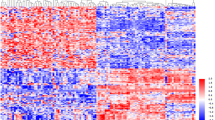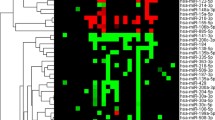Abstract
Background
In order to improve individual prognostication as well as stratification for adjuvant therapy in patients with clinically localized clear cell renal cell carcinoma (ccRCC), reliable prognostic biomarkers are urgently needed. In this study, microRNAs (miRNAs) have emerged as promising candidates. We investigated whether a combination of differently expressed miRNAs in primary tumors can predict the individual metastatic risk.
Methods
Using two prospectively collected biobanks of academic centers, 108 ccRCCs were selected, including 57 from patients with metastatic disease at diagnosis or during follow-up and 51 without evidence of metastases. Fourteen previously identified candidate miRNAs were tested in 20 representative formalin-fixed and paraffin embedded samples in order to select the best discriminators between metastatic and nonmetastatic ccRCC. These miRNAs were approved in 108 tumor samples. We evaluated the association of altered miRNA expression with the metastatic potential of tumors using quantitative polymerase chain reaction. A prognostic 4-miRNA model has been established using a random forest classifier. Cox regression analyses were performed for correlation of the miRNA model and clinicopathological parameters to metastasis-free and overall survival.
Results
Nine miRNAs indicated significant expression alterations in the small cohort. These miRNAs were validated in the whole cohort. The established 4-miRNA score (miR-30a-3p/-30c-5p/-139-5p/-144-5p) has been identified as a superior predictor for metastasis-free survival (hazard ratio 12.402; p = 7.0E−05) and overall survival (p = 1.1E−04) compared with clinicopathological parameters, and likewise in the Leibovich score subgroups.
Conclusions
We identified a 4-miRNA model that was found to be superior to clinicopathological parameters in accurately predicting individual metastatic risk and can support patient selection for risk-stratified follow-up and adjuvant therapy studies.


Similar content being viewed by others
References
Cohen HT, McGovern FJ. Renal-cell carcinoma. N Engl J Med. 2005;353:2477–90.
Dabestani S, Thorstenson A, Lindblad P, Harmenberg U, Ljungberg B, Lundstam S. Renal cell carcinoma recurrences and metastases in primary non-metastatic patients: a population-based study. World J Urol. 2016;34:1081–1086.
Ljungberg B, Bensalah K, Canfield S, et al. EAU guidelines on renal cell carcinoma: 2014 update. Eur Urol. 2015;67:913–24.
Leibovich BC, Blute ML, Cheville JC, et al. Prediction of progression after radical nephrectomy for patients with clear cell renal cell carcinoma: a stratification tool for prospective clinical trials. Cancer. 2003;97:1663–1671.
Youssef RF, Cost NG, Darwish OM, Margulis V. Prognostic markers in renal cell carcinoma: a focus on the ‘mammalian target of rapamycin’ pathway. Arab J Urol. 2012;10:110–117.
van Vlodrop IJH, Joosten SC, De Meyer T, et al. A four-gene promoter methylation marker panel consisting of GREM1, NEURL, LAD1, and NEFH predicts survival of clear cell renal cell cancer patients. Clin Cancer Res. 2017;23:2006–2018.
Buttner F, Winter S, Rausch S, et al. Survival prediction of clear cell renal cell carcinoma based on gene expression similarity to the proximal tubule of the nephron. Eur Urol. 2015;68:1016–20.
Rini B, Goddard A, Knezevic D, et al. A 16-gene assay to predict recurrence after surgery in localised renal cell carcinoma: development and validation studies. Lancet Oncol. 2015;16:676–85.
Brooks SA, Brannon AR, Parker JS, et al. ClearCode34: a prognostic risk predictor for localized clear cell renal cell carcinoma. Eur Urol. 2014;66:77–84.
Morgan TM, Mehra R, Tiemeny P, et al. A multigene signature based on cell cycle proliferation improves prediction of mortality within 5 yr of radical nephrectomy for renal cell carcinoma. Eur Urol. 2018;73:763–769.
Sanjmyatav J, Hauke S, Gajda M, et al. Establishment of a multicolour fluorescence in situ hybridisation-based assay for subtyping of renal cell tumours. Eur Urol. 2013;64:689–91.
Youssef YM, White NMA, Grigull J, et al. Accurate molecular classification of kidney cancer subtypes using microRNA signature. Eur Urol. 2011;59:721–730.
Cho WC. MicroRNAs: potential biomarkers for cancer diagnosis, prognosis and targets for therapy. Int J Biochem Cell Biol. 2010;42:1273–81.
Heinzelmann J, Henning B, Sanjmyatav J, et al. Specific miRNA signatures are associated with metastasis and poor prognosis in clear cell renal cell carcinoma. World J Urol. 2011;29:367–73.
Heinzelmann J, Unrein A, Wickmann U, et al. MicroRNAs with prognostic potential for metastasis in clear cell renal cell carcinoma: a comparison of primary tumors and distant metastases. Ann Surg Oncol. 2014;21:1046–54.
Fu Q, Liu Z, Pan D, et al. Tumor miR-125b predicts recurrence and survival of patients with clear-cell renal cell carcinoma after surgical resection. Cancer Sci. 2014;105:1427–34.
Slaby O, Redova M, Poprach A, et al. Identification of MicroRNAs associated with early relapse after nephrectomy in renal cell carcinoma patients. Genes Chromosomes Cancer. 2012;51:707–16.
Khella HW, Scorilas A, Mozes R, et al. Low expression of miR-126 is a prognostic marker for metastatic clear cell renal cell carcinoma. Am J Pathol. 2015;185:693–703.
Samaan S, Khella HW, Girgis A, et al. miR-210 is a prognostic marker in clear cell renal cell carcinoma. J Mol Diagn. 2015;17:136–44.
Fritz HK, Lindgren D, Ljungberg B, Axelson H, Dahlback B. The miR(21/10b) ratio as a prognostic marker in clear cell renal cell carcinoma. Eur J Cancer. 2014;50:1758–65.
Faragalla H, Youssef YM, Scorilas A, et al. The clinical utility of miR-21 as a diagnostic and prognostic marker for renal cell carcinoma. J Mol Diagn. 2012;14:385–92.
Zaman MS, Shahryari V, Deng G, et al. Up-regulation of microRNA-21 correlates with lower kidney cancer survival. PLoS ONE. 2012;7:e31060.
Teixeira AL, Ferreira M, Silva J, et al. Higher circulating expression levels of miR-221 associated with poor overall survival in renal cell carcinoma patients. Tumour Biol. 2014;35:4057–66.
Petillo D, Kort EJ, Anema J, Furge KA, Yang XJ, Teh BT. MicroRNA profiling of human kidney cancer subtypes. Int J Oncol. 2009;35:109–14.
Keller A, Leidinger P, Vogel B, et al. miRNAs can be generally associated with human pathologies as exemplified for miR-144. BMC Med. 2014;12:224.
Haas NB, Manola J, Uzzo RG, et al. Adjuvant sunitinib or sorafenib for high-risk, non-metastatic renal-cell carcinoma (ECOG-ACRIN E2805): a double-blind, placebo-controlled, randomised, phase 3 trial. Lancet. 2016;387:2008–16.
Ravaud A, Motzer RJ, Pandha HS, et al. Adjuvant sunitinib in high-risk renal-cell carcinoma after nephrectomy. N Engl J Med. 2016;375:2246–2254.
Motzer RJ, Haas NB, Donskov F, et al. Randomized phase III trial of adjuvant pazopanib versus placebo after nephrectomy in patients with locally advanced renal cell carcinoma (RCC) (PROTECT). J Clin Oncol. 2017;35:3916–3923.
Wu X, Weng L, Li X, et al. Identification of a 4-microRNA signature for clear cell renal cell carcinoma metastasis and prognosis. PLoS ONE. 2012;7:e35661.
Lokeshwar SD, Talukder A, Yates TJ, et al. Molecular characterization of renal cell carcinoma: a potential three-microRNA prognostic signature. Cancer Epidemiol Biomark. 2018;27:464–472.
Kowalik CG, Palmer DA, Sullivan TB, et al. Profiling microRNA from nephrectomy and biopsy specimens: predictors of progression and survival in clear cell renal cell carcinoma. BJU Int. 2017;120:428–440.
Hakimi AA, Voss MH. Genomic classifiers in renal cell carcinoma. Eur Urol. 2018;73:770–771.
Gerlinger M, Rowan AJ, Horswell S, et al. Intratumor heterogeneity and branched evolution revealed by multiregion sequencing. N Engl J Med. 2012;366:883–892.
Huang LL, Huang LW, Wang L, Tong BD, Wei Q, Ding XS. Potential role of miR-139-5p in cancer diagnosis, prognosis and therapy. Oncol Lett. 2017;14:1215–1222.
Yamada Y, Arai T, Kojima S, et al. Regulation of antitumor miR-144-5p targets oncogenes: direct regulation of syndecan-3 and its clinical significance. Cancer Sci. 2018;109:2919–2936.
Wang D, Zhu C, Zhang Y, et al. MicroRNA-30e-3p inhibits cell invasion and migration in clear cell renal cell carcinoma by targeting Snail1. Oncol Lett. 2017;13:2053–2058.
Mathew LK, Lee SS, Skuli N, et al. Restricted expression of miR-30c-2-3p and miR-30a-3p in clear cell renal cell carcinomas enhances HIF2alpha activity. Cancer Discov. 2014;4:53–60.
Acknowledgment
The authors thank Prof. Dr. Carsten Ohlmann and Dr. Johannes Linxweiler for critically reading this paper.
Funding
This study was supported by a grant from the Wilhelm-Sander-Stiftung, Germany (Grant Number 2014.0007.1), and additionally supported by the Robert Bosch Foundation.
Author information
Authors and Affiliations
Corresponding author
Ethics declarations
Conflict of interest
Joana Heinzelmann, Madeleine Arndt, Ramona Pleyers, Tobias Fehlmann, Sebastian Hoelters, Philip Zeuschner, Alexander Vogt, Alexey Pryalukhin, Elke Schaeffeler, Rainer M. Bohle, Mieczyslaw Gajda, Martin Janssen, Michael Stoeckle, and Kerstin Junker have no commercial interests in the subject matter of this study.
Additional information
Publisher's Note
Springer Nature remains neutral with regard to jurisdictional claims in published maps and institutional affiliations.
Electronic supplementary material
Below is the link to the electronic supplementary material.
Rights and permissions
About this article
Cite this article
Heinzelmann, J., Arndt, M., Pleyers, R. et al. 4-miRNA Score Predicts the Individual Metastatic Risk of Renal Cell Carcinoma Patients. Ann Surg Oncol 26, 3765–3773 (2019). https://doi.org/10.1245/s10434-019-07578-3
Received:
Published:
Issue Date:
DOI: https://doi.org/10.1245/s10434-019-07578-3




